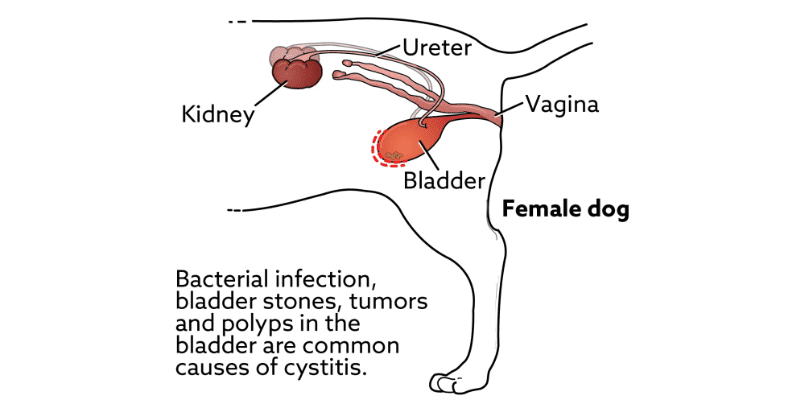Welcoming a furry friend into your home brings immeasurable joy, but it also comes with responsibilities, including safeguarding their health. One prevalent concern among dog owners is cystitis, a condition that affects the bladder. In this comprehensive guide, we will delve into the intricacies of cystitis in dogs, shedding light on its causes, symptoms, prevention, and treatment. By the end of this journey, you’ll be equipped with the knowledge to ensure your canine companion’s bladder health.

What is Cystitis in Dogs?
Cystitis in dogs refers to the inflammation of the urinary bladder, a condition that can cause discomfort and various urinary symptoms in our canine companions. The urinary bladder is a muscular organ that stores urine produced by the kidneys before it is expelled from the body through the urethra during urination. When the bladder becomes inflamed, it is known as cystitis.
Signs and Symptoms
Cystitis can manifest in various ways, and being attuned to your dog’s behavior is key to early detection. Watch out for subtle changes in their urinary habits, such as increased frequency, straining, or even visible blood in the urine. Dogs may also display signs of discomfort, restlessness, and lethargy. Transitioning to a veterinarian’s care promptly can make a significant difference in the outcome.
Cystitis in dogs can manifest through various signs and symptoms, and being attentive to your pet’s behavior is crucial for early detection. Here are common signs of cystitis in dogs:
- Increased Frequency of Urination: Dogs with cystitis may need to urinate more frequently than usual. You may notice them asking to go outside more often or struggling to hold their urine.
- Straining During Urination: Difficulty and straining during urination can be indicative of cystitis. Your dog may appear to be in discomfort or take longer than usual to empty their bladder.
- Blood in the Urine: One of the more noticeable signs is the presence of blood in the urine. If you observe a reddish or pink tint in your dog’s urine, it could be an indication of inflammation or infection in the bladder.
- Discomfort and Vocalization: Dogs with cystitis may exhibit signs of discomfort, including vocalization, whimpering, or signs of pain while urinating.
- Changes in Urine Color and Odor: Pay attention to any changes in the color and odor of your dog’s urine. Unpleasant smells or a strong ammonia-like odor may suggest an issue with the urinary tract.
- Excessive Licking of the Genital Area: Dogs may attempt to alleviate discomfort by licking their genital area excessively. If you observe increased licking, it could be a sign of irritation or inflammation.
- Changes in Drinking Habits: Cystitis may influence your dog’s water consumption. Some dogs may drink more water due to increased thirst, while others might reduce their intake as a response to pain.
- Lethargy and Behavioral Changes: Dogs with cystitis may exhibit signs of lethargy, reluctance to play, and changes in overall behavior. Pain and discomfort can lead to a decrease in energy levels.
- Fever: In more severe cases, cystitis can be accompanied by a fever. Check for signs of a higher-than-normal body temperature, such as warm ears and paws.
Causes of Cystitis in Dogs
Cystitis in dogs can be caused by various factors, and understanding these underlying causes is crucial for effective prevention and treatment. Here are common causes of cystitis in dogs:
- Bacterial Infections: Bacterial infections are a leading cause of cystitis in dogs. Bacteria, such as Escherichia coli (E. coli), can ascend the urethra and reach the bladder, leading to inflammation and infection.
- Urinary Tract Infections (UTIs): UTIs, which include infections in the bladder, can result from bacteria entering the urinary tract. Conditions that promote bacterial growth, such as incomplete emptying of the bladder or urinary tract abnormalities, can contribute to UTIs.
- Bladder Stones: The formation of bladder stones, composed of minerals and other substances, can irritate the bladder lining and lead to cystitis. Certain breeds may be more prone to developing bladder stones.
- Trauma or Injury: Physical trauma or injury to the urinary tract can cause inflammation of the bladder. This may include accidents, rough play, or any event that results in damage to the bladder or surrounding structures.
- Tumors: Tumors in the urinary tract, including the bladder, can lead to cystitis. Both benign and malignant tumors can cause inflammation and disrupt normal bladder function.
- Prostate Disease (in male dogs): Male dogs may develop cystitis as a result of prostate disease. Enlargement of the prostate can exert pressure on the urethra, leading to urinary tract issues.
- Autoimmune Conditions: Some autoimmune disorders can cause the immune system to attack the bladder lining, leading to inflammation and cystitis.
- Congenital Abnormalities: Dogs may be born with anatomical abnormalities in the urinary tract, making them more susceptible to cystitis. These abnormalities can affect normal urine flow and create an environment conducive to infection.
- Incontinence: Dogs experiencing incontinence, the inability to control urination, may be at a higher risk of developing cystitis. Incontinence can result from various factors, such as hormonal imbalances or weakening of the urinary sphincter.
- Diabetes Mellitus: Dogs with diabetes are more prone to urinary tract infections, which can contribute to cystitis. The presence of excess glucose in the urine provides a favorable environment for bacterial growth.
Understanding the specific cause of cystitis in a dog often requires a thorough examination and diagnostic tests conducted by a veterinarian. Tailoring the treatment approach to address the underlying cause is crucial for managing and preventing recurrent episodes of cystitis in dogs.
Preventing Cystitis in Dogs
Preventing cystitis in dogs involves a combination of proactive measures aimed at promoting overall bladder health and minimizing potential risk factors. Here are some key strategies for preventing cystitis in dogs:
- Ensure Proper Hydration: Adequate water intake is crucial for maintaining a healthy urinary system. Make sure your dog has access to clean and fresh water at all times. Encourage drinking, especially in warmer weather or for dogs prone to lower water consumption.
- Balanced Diet: Feed your dog a well-balanced and nutritionally complete diet. Consult with your veterinarian to choose a diet that meets your dog’s specific needs based on factors such as age, breed, and overall health.
- Regular Bathroom Breaks: Provide regular opportunities for your dog to relieve themselves. Consistent bathroom breaks help prevent the buildup of urine in the bladder, reducing the risk of bacterial growth and inflammation.
- Maintain a Healthy Weight: Obesity is a risk factor for various health issues, including urinary problems. Ensure your dog maintains a healthy weight through proper diet and regular exercise to reduce the risk of cystitis.
- Promote Regular Exercise: Regular physical activity contributes to overall well-being, including a healthy urinary system. Exercise helps maintain muscle tone and supports proper organ function.
- Maintain Good Hygiene: Keep your dog’s genital area clean to minimize the risk of bacterial contamination. Regular grooming can prevent dirt and bacteria from accumulating around the urethral opening.
- Prompt Veterinary Care: Address any signs of illness promptly. If you notice changes in your dog’s urinary habits, such as increased frequency, straining, or blood in the urine, consult with a veterinarian for a thorough examination and appropriate diagnostic tests.
- Preventive Veterinary Check-ups: Schedule regular veterinary check-ups to monitor your dog’s overall health. Routine examinations allow veterinarians to detect potential issues early and provide preventive care.
- Avoid Irritants: Minimize exposure to potential irritants in your dog’s environment. This includes avoiding harsh chemicals, certain household cleaners, and substances that may irritate the urinary tract.
- Manage Stress: Stress can contribute to various health issues, including urinary problems. Create a positive and stress-free environment for your dog, providing comfort and security.
- Consider Breed Predispositions: Some dog breeds may be more prone to certain urinary issues. Be aware of any breed-specific tendencies and discuss them with your veterinarian to tailor preventive strategies accordingly.
Treatment Options
The treatment of cystitis in dogs typically involves addressing the underlying cause of the condition and providing symptomatic relief. Here are common treatment options for cystitis in dogs:
- Antibiotics: If the cystitis is caused by a bacterial infection, the veterinarian will prescribe antibiotics to target and eliminate the bacteria. It’s crucial to complete the full course of antibiotics as prescribed, even if the symptoms improve before the medication is finished.
- Anti-Inflammatory Medications: Non-steroidal anti-inflammatory drugs (NSAIDs) may be prescribed to alleviate pain and reduce inflammation in the bladder. These medications help manage discomfort and improve the overall well-being of the dog.
- Pain Management: In cases where the dog is experiencing significant pain, the veterinarian may recommend pain management medications to provide relief. These medications can help improve the dog’s comfort during the recovery period.
- Fluid Therapy: Adequate hydration is essential for flushing out bacteria and promoting overall urinary health. In some cases, the veterinarian may recommend fluid therapy, which can involve intravenous (IV) fluids to ensure proper hydration.
- Dietary Changes: Dietary adjustments may be recommended to support bladder health. Prescription diets designed to dissolve certain types of bladder stones or to prevent their formation might be suggested. These diets are tailored to address specific nutritional needs.
- Urinary Acidifiers or Alkalinizers: Depending on the underlying cause of cystitis, the veterinarian may recommend urinary acidifiers or alkalinizers to create an environment in the bladder that discourages the formation of certain types of crystals or stones.
- Surgery: In cases where bladder stones or tumors are causing the cystitis, surgical intervention may be necessary. The veterinarian will discuss the options and potential benefits of surgery based on the specific diagnosis.
- Lifestyle and Environmental Changes: Modifying the dog’s lifestyle and environment may be advised to prevent recurrence. This can include promoting good hygiene, ensuring regular bathroom breaks, and minimizing exposure to potential irritants in the environment.
- Follow-Up Veterinary Visits: Regular follow-up visits are crucial to monitor the dog’s progress and adjust the treatment plan as needed. Follow-up urinalysis and other diagnostic tests may be conducted to ensure that the underlying issues are resolving.
It’s essential for pet owners to closely follow the veterinarian’s recommendations and complete the prescribed treatment course. Additionally, providing a comfortable and stress-free environment for the recovering dog is important for a successful recovery.
Always consult with a veterinarian for a proper diagnosis and treatment plan tailored to your dog’s specific condition and needs. Early intervention and consistent veterinary care play key roles in ensuring the best possible outcome for dogs with cystitis.
Read More About: https://drcmpetclinic.com/2023/12/16/urinary-tract-infection-in-dogs/
Find More Knowledge: https://www.aranimalclinic.com/blog/cystitis-dogs-cats/

